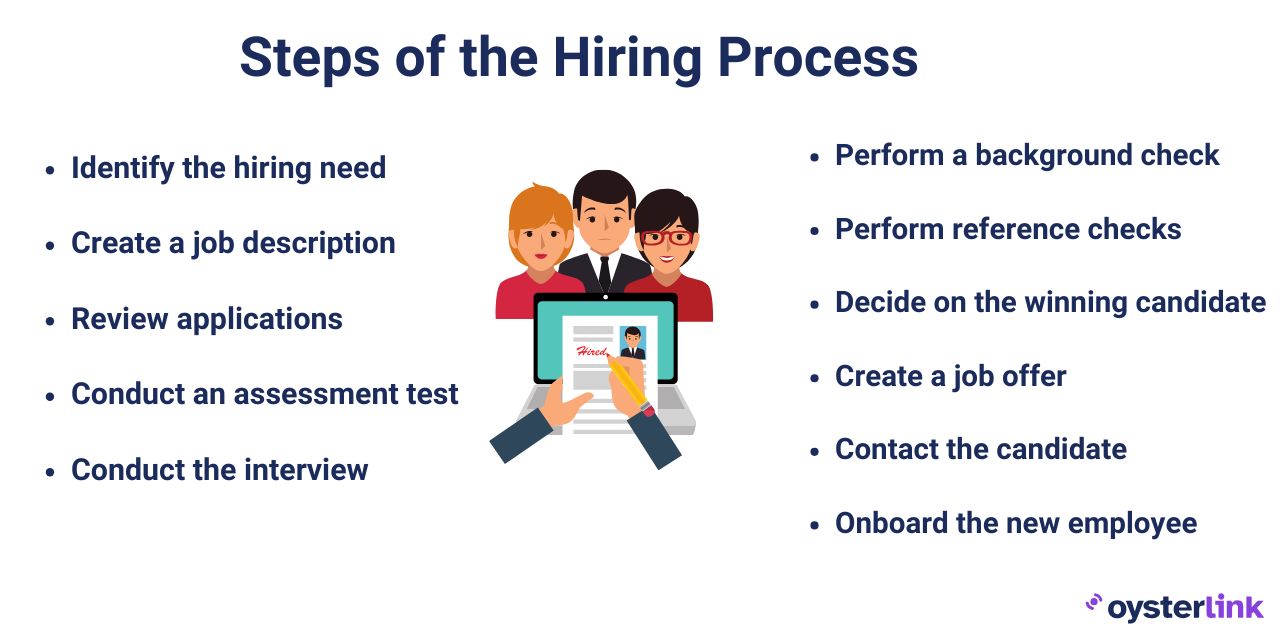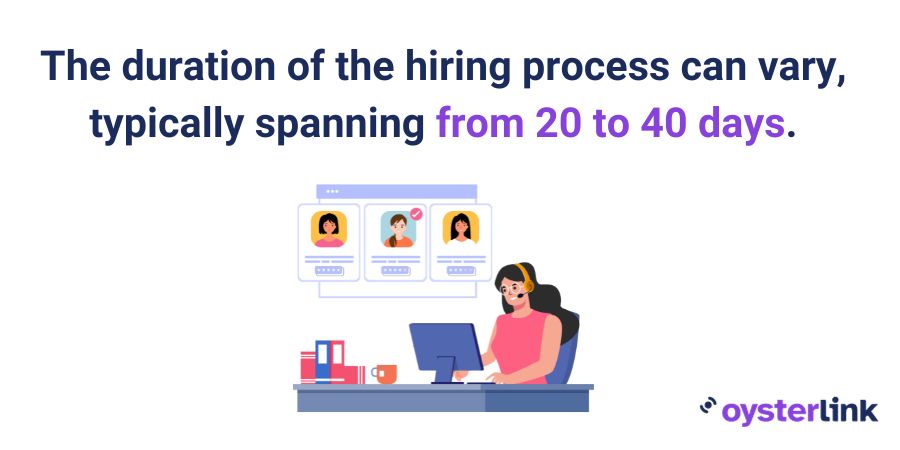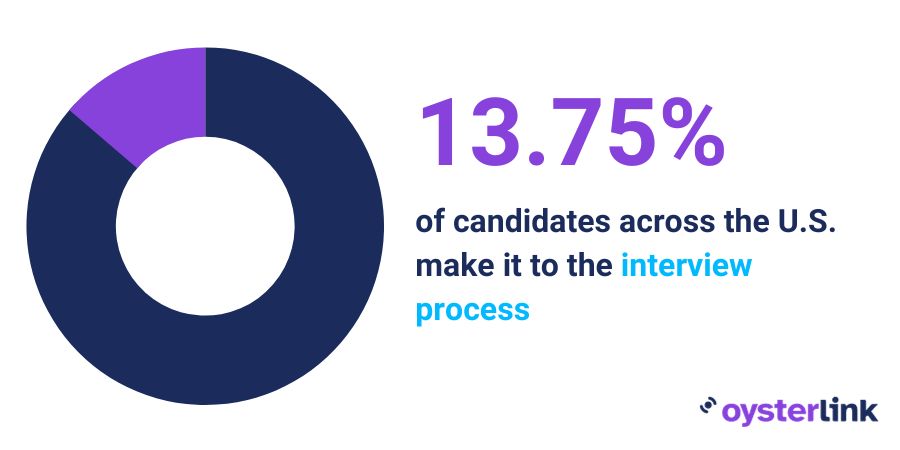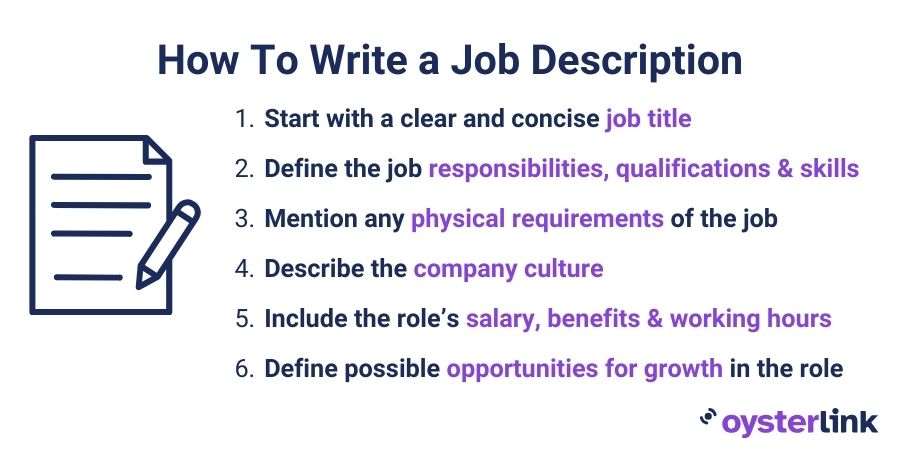From creating a job description to extending an offer to the most qualified candidate, a comprehensive hiring process is key to finding and recruiting top talent.
In this article, we’ll explain the detailed steps of the hiring process, share how to write a job description and cover frequently asked questions you might have as an employer, when looking for top candidates.

What Is the Hiring Process?
The hiring process is a series of steps that an employer takes to find and select the best candidate for an open position.
While you can customize your hiring process, steps include creating a job posting, reviewing applications, interviewing potential candidates and performing background checks on qualified candidates.
Typically, a human resource (HR) manager will lead the hiring process, together with a recruiter.

11 Steps of the Hiring Process
To recruit and hire a new employee, follow these 11 key steps:
1. Identify the hiring need
The first step in the hiring process is to identify the hiring need.
Determining exactly what role you need to fill allows you to write a transparent job description and find a suitable candidate for the position in order to meet both short-term and long-term company goals.
2. Create a job description
Next, create a job description that explains the responsibilities and requirements for the position.
The description should include the title of the position, the expectations for the role, the education, experience and skills required, and the benefits offered, such as the salary, paid time off and health-care benefits.
After creating the job description, you can advertise the job posting on digital job boards and on your website’s career page so that potential candidates could easily find it and apply.
(Check out our restaurant manager job description post to see an example!)
3. Review applications
Once you receive cover letters and resumes from hopeful candidates through email or an applicant tracking system, it’s time to carefully review each application one by one.
This step allows you to eliminate candidates who do not meet the requirements for the position and identify the most qualified candidates to move to the next stage of the process.
4. Conduct an assessment test
Before going straight to the interview stage, you might choose to conduct an assessment test on the candidates you’ve shortlisted based on their skills and experience.
An assessment test can help you evaluate the candidate’s skills, work style, technical abilities and knowledge needed for the position.
To conduct an assessment test:
- Determine the test format: Choose the format that best suits your purpose, such as multiple choice, true or false or essay. For example, if you’re looking to hire a restaurant manager, you might want to create a Criteria Basic Skills Test (CBST) to evaluate their verbal skills and attention to detail.
- Administer the test: Decide on a time and location—whether on-site or online—for the test. Distribute the test to the candidates and provide the necessary instructions.
- Score the test: Use a scoring guide or rubric to evaluate the candidate’s responses and determine the results of the test.
- Determine which candidates you want to move forward with: Use the test results to further evaluate the candidates and determine which candidates should move to the next step in the hiring process—the interview.
5. Conduct the interview
Conduct interviews with the candidates who scored well on the assessment test, in person, by phone or via video call.
A job interview allows you to get to know the candidate, and ask questions about their skills and experience so you can determine whether they are a good fit for the role.
In this stage, you will only interview a small pool of top candidates. In fact, according to a 2019 industry report, only 13.75% of candidates across the U.S. make it to the interview process.

To conduct a job interview:
- Prepare for the interview: Review the job description and the candidate’s resume, and come up with a list of questions to ask.
- Welcome the candidate: Greet the candidate, introduce yourself and tell them about the company and the role.
- Start with small talk: Engage the candidate in casual conversation to help put them at ease and get to know them better.
- Ask questions: Begin asking the questions you prepared in advance. You may also want to ask follow-up questions based on the candidate’s responses.
- Allow the candidate to ask questions: Encourage the candidate to ask questions about the job, the company, and the team. This will give them a chance to learn more about the opportunity and assess whether it is a good fit for them.
- Thank the candidate: At the end of the interview, summarize the key points and qualifications of the candidate. Thank the candidate for their time and let them know when they can expect to hear back about the next steps in the hiring process.
6. Perform a background check
If needed, you can further narrow down your top candidates by running a background check, in-house or by outsourcing.
This allows you to confirm a candidate’s employment history, educational qualifications, criminal records and more.
You can also check social media accounts—such as Facebook and Twitter—to ensure that potential employees can professionally represent your company.
Background checks reassure you that your potential candidates are reliable and don’t pose risks to your company.
7. Perform reference checks
In one of the final stages of the employee selection process, you can perform reference checks by reaching out to the references each candidate provided—most often, former employers or co-workers—to verify skills, work history and previous job performance.
Reference checks can help you make a more informed decision regarding which candidate to hire.
8. Decide on the winning candidate
Once you’ve conducted background and reference checks, it’s time to select your winning candidate.
In case the winning candidate declines the offer, have a backup candidate in mind.
9. Create a job offer
The hiring process can be stressful, but at this point it’s about to close—it’s time to create a job offer!
A job offer is your official proposal to the winning candidate. Think of it as a formal invitation where you ask the candidate to work for the company and join your team.
In your job offer, include:
- The job title and description
- The salary and benefits
- Other terms of employment such as the start date, working hours and contract length
10. Contact the candidate
Whether you are extending a job offer via call or email, follow these tips when contacting the qualified candidate:
- Prepare ahead: Make sure you have all the necessary information at hand, like salary and benefits.
- Introduce yourself: Begin the follow-up call or email by re-introducing yourself and explaining that you are contacting the candidate to extend a job offer.
- Outline the job offer details: Explain the terms of the job offer—such as the job title, start date, salary and any benefits or perks that are included.
- Encourage the candidate to ask questions: Accepting a new role can be both exciting and nerve-racking, so give the candidate some time to ask questions.
- Confirm the candidate’s acceptance: Finally, confirm the candidate’s acceptance and make sure you agree on all details, then ask the candidate to accept the position in writing.
11. Onboard the new employee
Once the applicant accepts the job offer, it’s time to bring the new employee on board.
In this final stage of the hiring process, you’ll need to introduce the new employee to your team, the company culture and their workspace.
Depending on the role, the onboarding process may take several days to several weeks. Make sure you have an onboarding plan mapped out and ready to go, so your new employee knows what to expect and prepare for each day, while they get accustomed to their new position.
How to Write a Job Description
A job description provides candidates with a clear understanding of the role and the expectations they must meet once they’re employed.
To write a job description, follow these steps:
- Start with a clear and concise job title that accurately reflects the position
- Define the job responsibilities, along with the required and preferred qualifications, skills and working hours.
- Mention any physical requirements of the job—such as the ability to lift a certain amount of weight or stand for long periods of time
- Describe the company culture and unique aspects of the working environment
- Include the role’s salary and benefits (some states require transparency in salary ranges when hiring)
- Define possible opportunities for growth in the role

Hospitality Hiring Process FAQs
1. How many candidates should be shortlisted for an interview?
Shortlisting three to five people is a good rule of thumb when narrowing down the number of candidates for an interview.
2. Who should interview candidates in the hiring process?
Typically, the hiring process involves:
- A recruiter: A recruiter is responsible for finding, screening and selecting job candidates for your company. You can employ in-house recruiters or you can outsource services from a recruitment agency that works with multiple companies to fill job openings.
- A hiring manager: A hiring manager is responsible for supervising the recruitment and selection of potential employees. A hiring manager’s role includes making recommendations for new hires that will be endorsed to the HR department and upper management.
- A member of the leadership team: A member of your leadership team can offer insight into the long-term goals and vision of your company and assesses a candidate’s leadership skills such as teamwork, problem solving and decision-making.
Ultimately, the individuals who are involved in the interview process will depend on the structure of your company and the role being filled.
3. What should a career page include?
On your company’s career page, include a list of open positions, clear instructions on how to apply and details about your company culture, values, mission and vision. Including employee testimonials can also help potential candidates get a glimpse into what it’s like to join your team.
4. What are the benefits of providing post-interview feedback?
The number one pain point for candidates during the hiring process is waiting for feedback post-interview. In fact, 53.5% of job candidates said they did not receive feedback after a job interview in 2018, leaving them with questions.
Providing post-interview feedback allows you to:
- Show professionalism and respect to potential employees
- Ensure candidates that you value the time and effort they put into the application process
- Help candidates understand their strengths and weaknesses so they can make improvements for future job searches
- Improve the hiring process experience so candidates can continue to see your company in a positive light
Subscribe to OysterLink for Latest Employment Insights
The hiring process is a series of steps that allows you to provide a clear understanding of expectations for an open role, and find the best candidate for the job.
Looking to hire top talent for your restaurant, hotel, bakery or similar hospitality establishment?
OysterLink helps connect restaurant industry employers with potential candidates. Sign up for early access to curated industry insights straight to your inbox!






